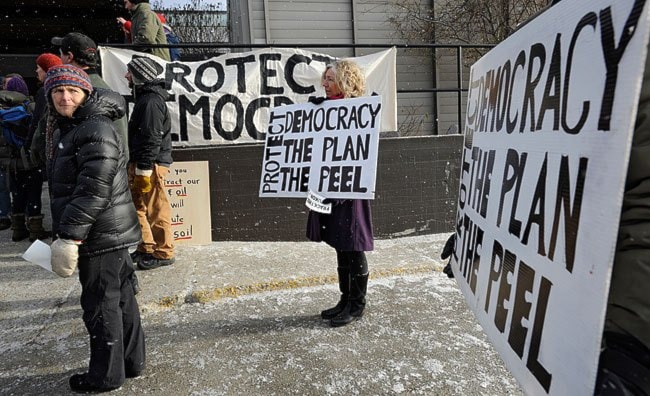The government’s proposed changes to the Peel land use plan amount to an overhaul of the recommended plan and run afoul of treaty obligations, critics say.
Over 100 protesters gathered in front of the legislature yesterday to voice their displeasure with the government’s newly released scenarios, which would provide miners with greater opportunities to operate in the remote region.
“The government is using the language of balance and fairness to sell a one-sided, pro-development vision to the Yukon public,” Liz Hanson, leader of the Yukon NDP, told the members of the legislature and a full gallery of public observers.
The government is attempting to deliberately mislead the public by presenting their ideas within the language of protection, she added.
Under the Umbrella Final Agreement, the land claims treaty that outlines in detail the land planning process for the territory, the government is required to take the planning commission’s Final Recommended Plan to the public for consultation.
Only after that can the government choose to reject, accept, or propose modifications to the plan, said Hanson in an interview. The Yukon Party has skipped that crucial step, she asserted.
“They’ve jumped to proposing modifications, and in my view that’s not good faith.”
The concepts proposed by the government this week do not follow from the planning process, and amount to a rejection of the years of hard work the planning commission, Yukon First Nations and the public have put into the plan, said Dave Loeks, who headed the Peel Watershed Planning Commission.
“The people of the Yukon and the First Nations had said that the undeveloped nature of the Peel, primarily characterized by roadlessness, was what was really, really important to them,” said Loeks.
The commission’s final plan was a carefully crafted compromise that would preserve the roadless character of 80 per cent of the area while allowing for the continued development of existing claims throughout the region using air access, he said.
Twenty-five per cent of the area would be protected only in the interim, subject to review every 10 years.
Politicians and technical advisers insisted at a press conference this week that the Yukon Party’s “protected area” designation offers a similar level of protection to the commission’s “special management areas.” But the concepts put forward by the government do not rule out the construction of roads anywhere in the Peel.
Even in the most protected zones, existing claim holders could apply for permits to build roads to develop their claims, provided they meet stricter environmental standards.
The government has so far provided little information as to what those standards would be and how they would be applied.
And roads, for environmentalists, tourism operators and First Nations, are the crucial question.
“You can never go backwards and create wilderness after you’ve put in roads and mines and gas fields,” said Karen Baltgailis with the Yukon Conservation Society.
Roads open up areas for more development by encouraging access and increasing the value of other mineral claims in the area, she added.
The government’s modifications suggest that even in sensitive river corridors, “temporary” roads could be permitted.
“In my experience, there’s no such thing as a temporary road,” said Baltgailis.
If there was any question that Independent MLA Darius Elias has been courting favour with the Yukon Party since his departure from the Liberals, they can now be silenced.
The government’s actions this week on the Peel show disrespect to First Nation governments, the Yukon public, and the planning process, Elias said.
“My first thoughts were like ‘Wow’ and in the words of my teenage sons, ‘Seriously?’” said Elias.
He said the he supports the final recommended plan and the process that led to it.
Elias fears that the public will lose faith in the planning process and consensus on negotiated treaties with First Nations, he said.
If this ends up in the courts, the consequences for Yukon and for Canada spell trouble for the economy, said Elias.
“Make no mistake: this is headed towards litigation if the government continues down this dangerous path.”
MLA Sandy Silver, leader of the Yukon Liberals, has also criticized the government for skirting their obligations under the land planning process.
“It’s unfortunate that the government wasn’t honest with Yukoners about what it wanted from the plan process when it started many years ago. A great deal of time and effort has been lost,” said Silver.
He called the new concepts a completely new plan, which take little from the recommendations of the commission.
If the government wanted to make specific recommendations about what they wanted the plan to look like, they had the opportunity to do so over the planning process, said Loeks.
After the draft plan, all the affected governments were asked to carefully review the proposal and provide clear recommendations for modifications with detailed explanations.
The government’s response at that time was “thin” and only alluded to wanting a more “balanced” plan and to revisit the question of access, said Loeks.
“Sorry, that’s not good enough.”
The government has engaged in “bad faith participation” with the planning process, said Loeks.
“It’s a little bit like getting to the last down of the Super Bowl, putting down the ball and walking off the field and saying, ‘We don’t like the rules here.’ And expecting everybody to say, ‘Oh I guess we’ll do a new game,’ right?”
The foundation for the territory’s economic prosperity has been the shared commitment to the treaty agreements under the Umbrella Final Agreement, he added.
“Lacking that consensus, the sort of certainty that industry is looking for is going to evaporate pretty quickly.”
Simon Mervyn, chief of the First Nation of Nacho Nyak Dun, who speaks on behalf of the First Nations involved in the Peel plan, has said in the past that the government could be opening itself up to a legal battle.
Mervyn was out of the office this week and could not be reached for comment.
Contact Jacqueline Ronson at
jronson@yukon-news.com
